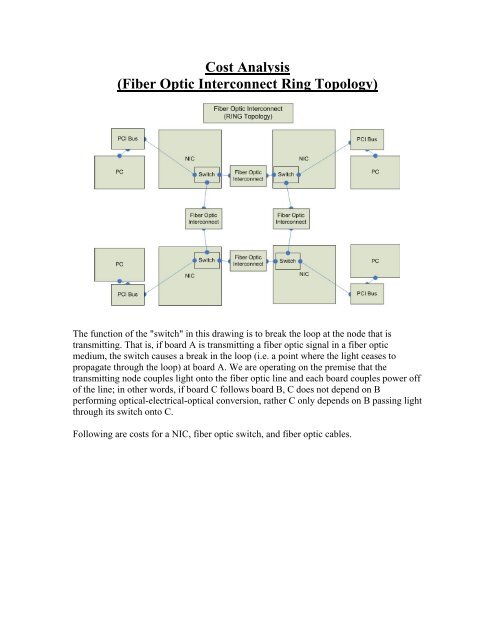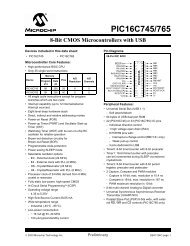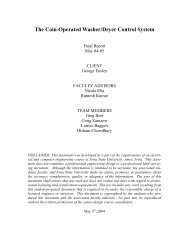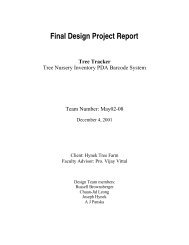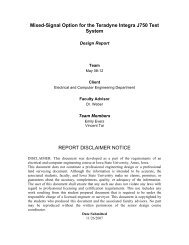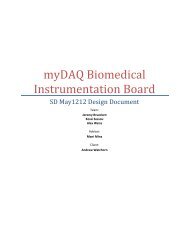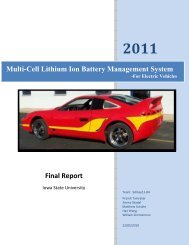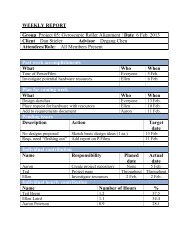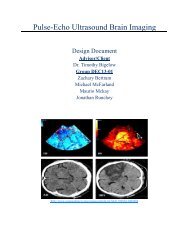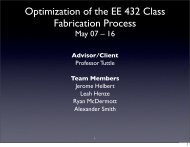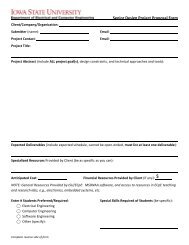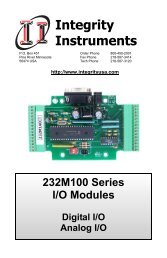Cost Analysis (Fiber Optic Interconnect Ring Topology)
Cost Analysis (Fiber Optic Interconnect Ring Topology)
Cost Analysis (Fiber Optic Interconnect Ring Topology)
You also want an ePaper? Increase the reach of your titles
YUMPU automatically turns print PDFs into web optimized ePapers that Google loves.
<strong>Cost</strong> <strong>Analysis</strong><br />
(<strong>Fiber</strong> <strong>Optic</strong> <strong>Interconnect</strong> <strong>Ring</strong> <strong>Topology</strong>)<br />
The function of the "switch" in this drawing is to break the loop at the node that is<br />
transmitting. That is, if board A is transmitting a fiber optic signal in a fiber optic<br />
medium, the switch causes a break in the loop (i.e. a point where the light ceases to<br />
propagate through the loop) at board A. We are operating on the premise that the<br />
transmitting node couples light onto the fiber optic line and each board couples power off<br />
of the line; in other words, if board C follows board B, C does not depend on B<br />
performing optical-electrical-optical conversion, rather C only depends on B passing light<br />
through its switch onto C.<br />
Following are costs for a NIC, fiber optic switch, and fiber optic cables.
(Summary of <strong>Cost</strong> Information)<br />
10-Gigabit Network Interface Card: $895.00 at a quantity 4 = $3,580.00<br />
Network Interface Card XFP Tranciever: $900.00 at a quantity 4 = $3,600.00<br />
<strong>Fiber</strong> <strong>Optic</strong> Cable: $65.00 at a quantity of 4 = $260.00<br />
High Speed Switches: $1,640.00 at a quantity of 4 = $6,560.00<br />
Total <strong>Cost</strong> of Proposed <strong>Fiber</strong> <strong>Optic</strong> <strong>Interconnect</strong>: $14,000.00<br />
Requirement Details:<br />
• 4 NIC with 10 Gbit Capabilities<br />
• 20ft. of fiber optic cable (type depending on the NIC selected)<br />
• 4 High Speed Switches ( 2-in/2-out)<br />
10-Gigabit Network Interface Card Recommendation:<br />
Company: Myri-10G 10-Gigabit Ethernet Solutions<br />
Product Code: 10G-PCIE-8A-R<br />
Price: $895.00<br />
Quantity: 4<br />
(Myri-10G PCI-Express NIC with a 10GBase-R port)<br />
Specs can be located on the web at the following address:<br />
http://www.myri.com/Myri-10G/NIC/10G-PCIE-8A-R.html<br />
NIC Specs(Partial):<br />
Myri-10G network port: 10GBase-R, 10+10 Gbit/s data rate, full-duplex. Serial data is<br />
carried on a single fiber in each direction at 10.3125 GBaud, 64b/66b-encoded.<br />
Depending upon the XFP transceiver plugged into the socket in the PCI faceplate, the
port is 10GBase-SR (850nm wavelength, 26-300m on multimode fiber), 10GBase-LR<br />
(1310nm wavelength, up to 10km on single-mode fiber), or 10GBase-ER (1550nm<br />
wavelength, up to 40km on single-mode fiber). The port can operate with either Ethernet<br />
or Myrinet protocols at the Data Link layer. When operating in Ethernet mode, the port<br />
supports Ethernet flow control as defined by IEEE 802.3x. The allowed length of the<br />
fiber cable depends upon the XFP transceiver and the quality of the fiber, but in Myrinet<br />
mode must not exceed 200m due to Myrinet flow control. (See this Brief Guide to Myri-<br />
10G PHYs, pdf, 35KB.)<br />
PCI-Express host port: This NIC is a x8 (8 lane) PCI-Express Add-in Card. It is capable<br />
of exchanging data with a host computer at up to 2 GBytes/s (250 MBytes/s per lane)<br />
data rate in each direction, full-duplex. The port is fully compliant with the PCI-Express<br />
Card Electromechanical Specification Rev. 1.1, and with the PCI-Express Base<br />
Specification Rev. 1.0a. The circuit-board edge connector of the NIC will fit<br />
mechanically in x8 or x16 physical slots in host computers. The NIC auto-negotiates<br />
operation in the widest available mode supported by the slot it is plugged into (x8, x4, x2,<br />
or x1).<br />
NIC Accessories: (XFP tranciever)-XFPs for 10GBase-R. The IEEE 802.3ae 10-Gigabit<br />
Ethernet Standard specifies PHYs with 10.3125-GBaud, 64b/66b-encoded, packet data<br />
over serial fiber at three wavelengths: 10GBase-LR (1310nm, single-mode fiber to 10km)<br />
XFP Price: $900.00<br />
Quantity: 4<br />
<strong>Fiber</strong> <strong>Optic</strong> Cable Recommendation:<br />
Company: Stonewall Cable, Inc<br />
Product Number: F083-D22AA0<br />
Product Description: Singlemode 8.3/125 Duplex FC / FC <strong>Fiber</strong> <strong>Optic</strong> Cable<br />
Price: $65.00<br />
Quantity: 4<br />
3 meter cables, available from www.stonewallcable.com.
High Speed Switch Recommendation:<br />
Company: Thorlabs<br />
Product Number: FS702<br />
Part Description: 1 x 2 Solid-State Singlemode <strong>Fiber</strong> <strong>Optic</strong> Switch, No Connectors<br />
Price: $1,640.00<br />
Quantity: 4<br />
(Solid State <strong>Fiber</strong> <strong>Optic</strong> Switch)<br />
Solid-State <strong>Fiber</strong> <strong>Optic</strong> Switch Specifications<br />
Min Typ Max<br />
Operating Wavelength 1520nm 1610nm<br />
Switching Speed 50µs 200µs<br />
Insertion Loss 0.7dB 1dB<br />
Cross Talk 40dB 50dB 60dB<br />
Polarization Dependent<br />
Loss<br />
Polarization Mode<br />
Dispersion<br />
0.1dB<br />
0.1ps<br />
Return Loss 55dB<br />
0.2dB<br />
Current Consumption ±120mA ±150mA ±200mA<br />
Drive Voltage 5V<br />
Drive Pulse 0.2ms 0.3ms 10ms<br />
Max optical power 300mW<br />
Dimensions (L) 52 x (W) 7 x (H) 8mm<br />
<strong>Fiber</strong> 1 meter SMF-28<br />
Operating Temperature 0 70C
-from Thorlabs website.<br />
The fiber optic loop is created when light coming from board n-1 enters the switch from<br />
N.C. (normally closed). With the switch closed, COM then acts as a conduit for the light<br />
coming from N.C. With the switch open, no light is transmitted from N.C. to COM, but<br />
light is transmitting from N.O. (normally open) to COM. With the switch "open" I can<br />
transmit from board n to board n+1 through the switch, and when the light signal has<br />
gone around the loop completely and is coming into the switch from N.C., the light<br />
cannot propagate any farther.<br />
Getting light off of the fiber (for each board's receiver line) could be done by sitting two<br />
such switches back to back, i.e. COM 1 feeding COM2, and then a board could switch<br />
between passing the light from COM 2 to N.C. 2, or receiving the signal into N.O. 2.<br />
However, this would prevent any board farther down the chain from receiving such a<br />
signal. The less painful method would be to have something light a 20dB coupler at COM<br />
to bring 1% of the signal off to any given board's receive and pass 99% of the signal on to<br />
the next board. The choice of coupler is driven by the power output of the transceiver on<br />
board x and the reception threshold for the transceiver on board y.


